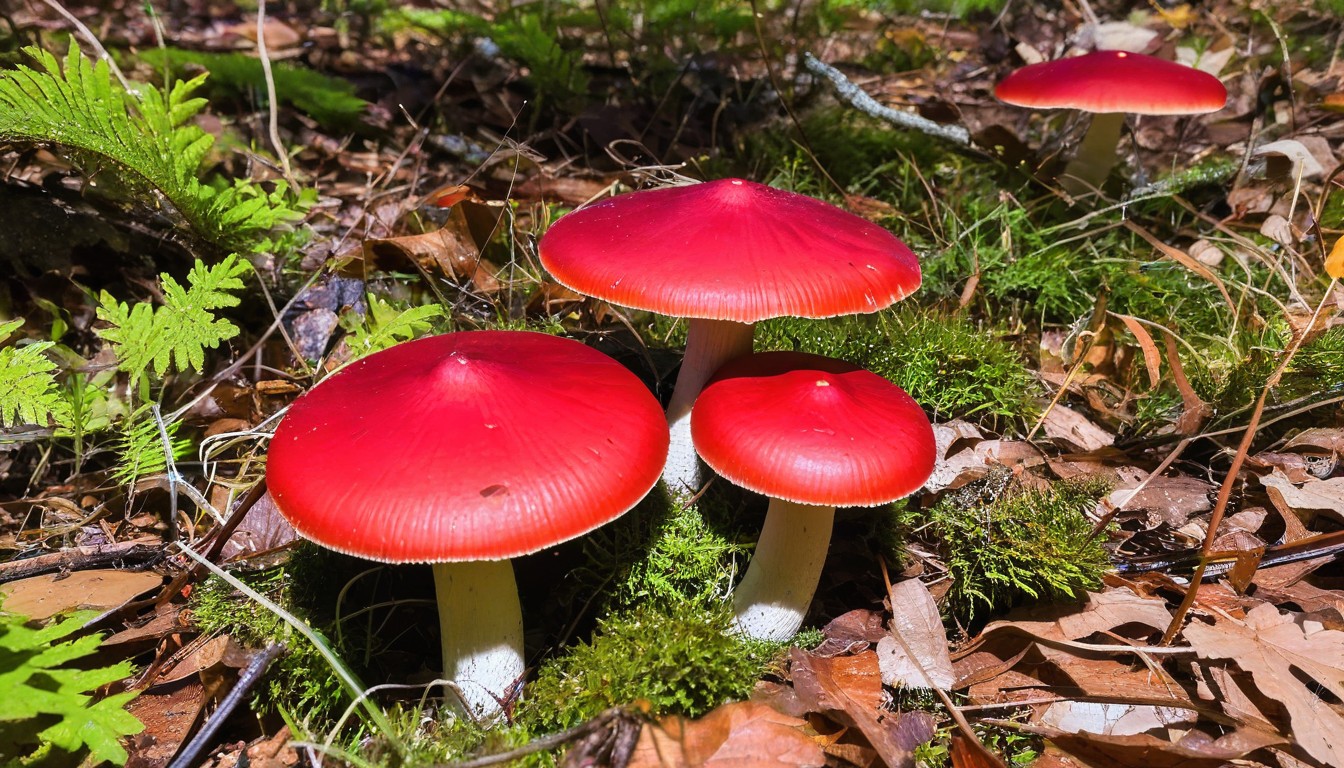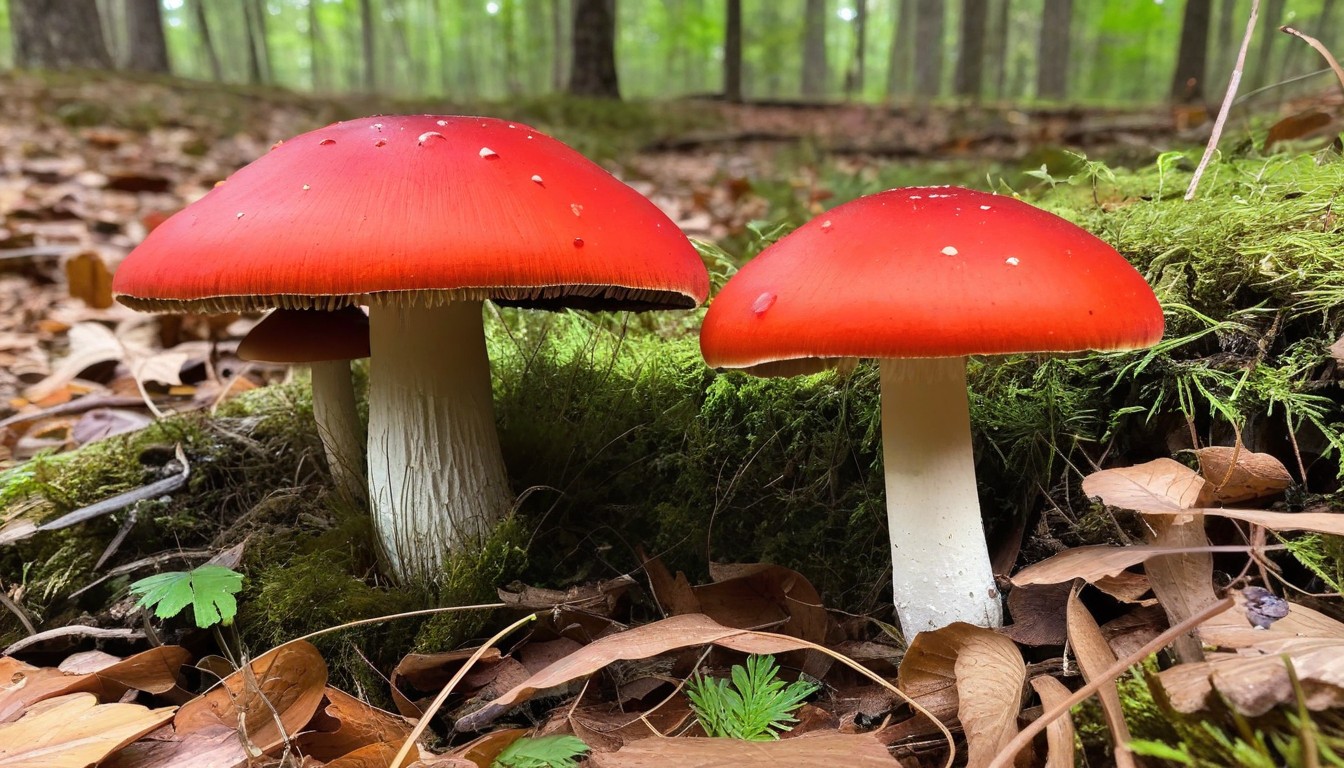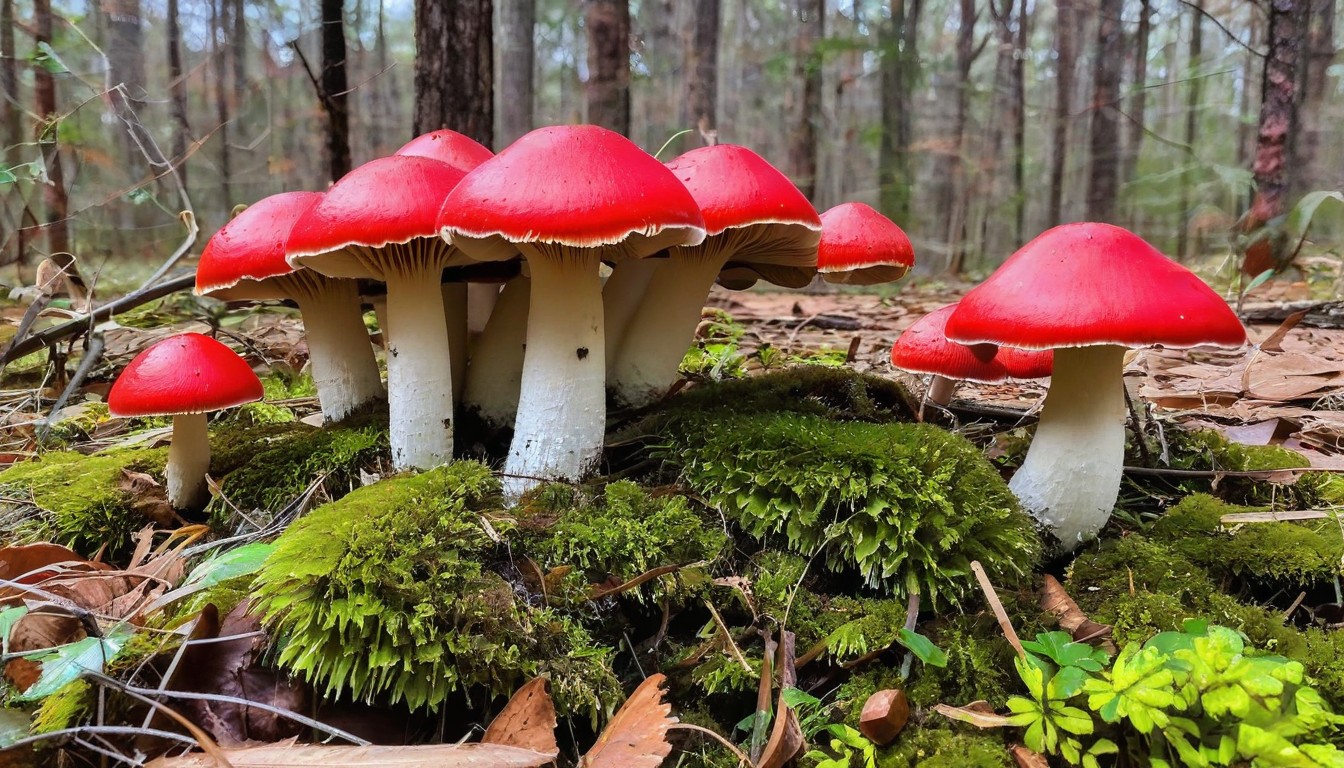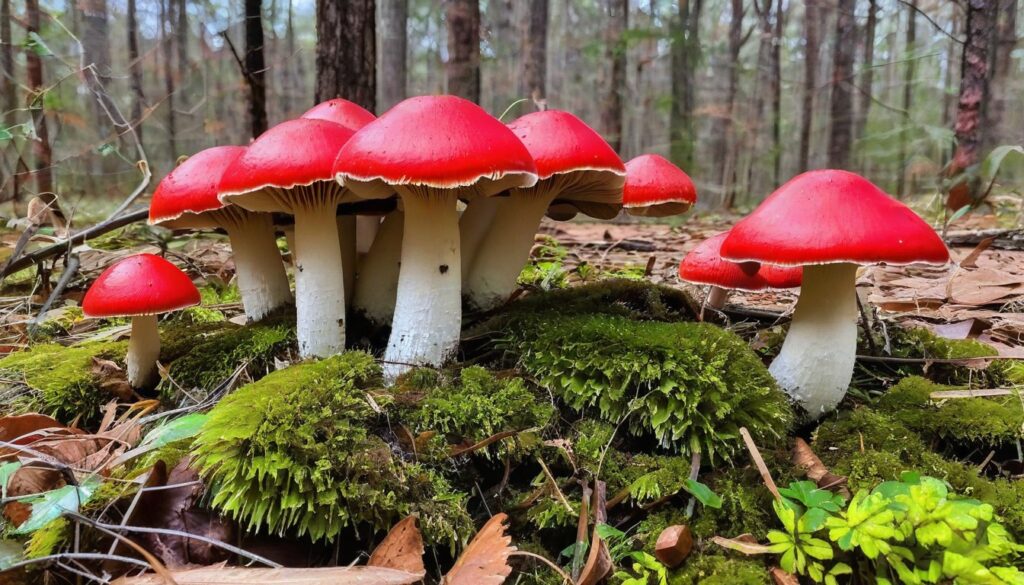Minnesota is a haven for red mushrooms, a stunning variety of fungi that thrives in the state’s pristine forests and grasslands. These vibrant mushrooms are a sight to behold, with their bold colors and fascinating shapes making them a popular subject for photographers and nature enthusiasts alike.
What makes red mushrooms so mesmerizing? And where can you find them in Minnesota? Read on to discover more about these captivating fungi and their role in the state’s ecosystem.
Key Takeaways:
- Minnesota is a haven for red mushrooms, a stunning variety of fungi that thrives in the state’s pristine forests and grasslands.
- Red mushrooms are a popular subject for photographers and nature enthusiasts alike.
- Read on to discover more about these captivating fungi and their role in the state’s ecosystem.
An Introduction to Minnesota’s Mushroom Diversity
Mushrooms are a fascinating and integral part of Minnesota’s diverse ecosystem. With its rich soil, lush forests, and varied climate, the state is home to numerous mushroom species, each with its unique color, shape, and texture. From the iconic red and white spotted Amanita muscaria to the delicate Hygrocybe miniata, Minnesota’s mushroom diversity is a wonder to behold.
The state’s mushroom diversity underpins the growth of red mushrooms, which are the focus of this article. Understanding this rich and diverse ecosystem is essential to appreciating the thriving community of fungi in Minnesota’s wilds.
Overview of Minnesota’s Mushroom Diversity
Minnesota’s ecosystem supports the growth of a wide range of mushroom species, each with its unique characteristics. The following table provides an overview of some of the common mushroom species found in Minnesota and their preferred habitats:
|
Mushroom Species |
Preferred Habitat |
|---|---|
|
Chanterelle (Cantharellus cibarius) |
Deciduous forests with high soil moisture |
|
Morel (Morchella spp.) |
Open areas with well-drained soil |
|
Oyster Mushroom (Pleurotus ostreatus) |
Dead hardwoods |
|
Shaggy Mane (Coprinus comatus) |
Grassy areas with high moisture |
|
Winter Mushroom (Flammulina velutipes) |
Dead hardwoods, especially elm and maple |
Minnesota’s mushroom diversity is a testament to the vitality and complexity of its ecosystems. Each mushroom species has a unique role to play and contributes to the state’s biodiversity in significant ways. As you explore the wilds of Minnesota, keep an eye out for these fascinating fungi, and take the time to appreciate their beauty and value.
Types of Red Mushrooms Found in Minnesota
Minnesota is home to a diverse array of red mushrooms, each with its distinct characteristics and appearances. Let’s take a closer look at some of the most common types of red mushrooms found in the state:
|
Mushroom |
Scientific Name |
Appearance |
Notes |
|---|---|---|---|
|
Fly Agaric |
Amanita muscaria |
Bright red cap with white spots |
Can be toxic if consumed raw; used in shamanic practices in some cultures |
|
Red Chanterelle |
Cantharellus cinnabarinus |
Thin, trumpet-like shape with a fiery red hue |
Can be eaten cooked and has a slightly sweet flavor; often used as a garnish |
|
Scarlet Cup |
Sarcoscypha coccinea |
Bright red, cup-shaped cap with small hairs on the outer edges |
Commonly found on decaying wood and logs; edible but not very flavorful |
|
Giraffe Spots |
Chroogomphus vinicolor |
Reddish-brown cap with distinctive “giraffe-like” spots |
Can be eaten cooked and has a slightly nutty flavor; often found in coniferous forests |
|
Berkeley’s Polypore |
Bondarzewia berkeleyi |
Deep red cap that can grow up to 30 cm wide |
Commonly found on dead or dying hardwood trees; can be eaten if cooked thoroughly |
These are just a few examples of the wide variety of red mushrooms that can be found in Minnesota. As always, it’s essential to be cautious and knowledgeable about mushroom identification, especially when it comes to toxic species. If in doubt, seek guidance from an experienced forager or mycologist.
Ideal Habitat for Red Mushrooms in Minnesota

If you want to spot red mushrooms in Minnesota, it is important to know their ideal habitat. These mushrooms grow in specific environments, and identifying those environments can increase your chances of a successful sighting.
The ideal habitat for red mushrooms in Minnesota includes areas that are moist, with well-drained soil and a slightly acidic pH level. These mushrooms thrive in areas with partial shade and require specific types of trees for growth.
Soil Composition
The type of soil is crucial for the growth of red mushrooms in Minnesota. They prefer well-drained soil that is rich in organic matter and slightly acidic. Organic matter provides the fungi with the nutrients they need to grow and thrive.
If you’re looking for red mushrooms in Minnesota, keep an eye out for areas with soil that is dark and rich in nutrients. These areas provide the perfect environment for red mushrooms to grow comfortably.
Moisture and Temperature
Red mushrooms in Minnesota prefer a cool and moist environment. It is essential to look for areas with a slightly high humidity level, such as forests and moist areas where water is abundant. During summer months, there is usually a lot of rainfall in Minnesota, creating conditions ideal for mushroom growth.
It is also important to consider the average temperature in your target location. These mushrooms grow best in temperatures between 50°F to 80°F. The warm summer and spring months provide the best time for red mushrooms to sprout and grow.
Tree Types
Red mushrooms in Minnesota have a symbiotic relationship with specific types of trees. They usually grow beneath conifers such as spruce, fir, and pine trees. Therefore, it is essential to survey areas rich in these types of trees to increase your chances of finding red mushrooms.
Summary
The ideal habitat for red mushrooms in Minnesota includes well-drained soil that is rich in organic matter and slightly acidic. These mushrooms thrive in areas with partial shade and a cool and moist environment. They grow best under conifers such as spruce, fir, and pine trees.
Where to Spot Red Mushrooms in Minnesota
If you’re an avid hiker and nature enthusiast, there’s no better place to spot red mushrooms in Minnesota than its many state parks and forests. These habitats provide the ideal environment for red mushrooms to flourish, boasting nutrient-rich soil, ample moisture, and the perfect temperature.
Tip: Check out the following trails and locations for the best chances of spotting these vibrant fungi:
|
Hiking Trail/Location |
Red Mushroom Species Found |
|---|---|
|
Birch Spring Trail, Chippewa National Forest |
Amanita muscaria, Hygrocybe miniata, Russula emetica |
|
Split Rock Lighthouse State Park |
Hygrocybe miniata, Amanita muscaria, Clitocybe sp. |
|
Tettegouche State Park |
Amanita muscaria, Russula emetica, Hygrocybe miniata |
Remember to practice safe and responsible mushroom foraging, and always leave the habitat undisturbed. Happy mushroom hunting!
The Role of Red Mushrooms in Minnesota’s Ecosystem

Red mushrooms play a vital role in Minnesota’s ecosystem, forming mutually beneficial relationships with trees and other plants. These fungi are known as mycorrhizal symbionts, meaning they develop an interconnected network of hyphae (fine fungal filaments) that extend outwards and enter the roots of various plant species. As a result, red mushrooms help plants absorb necessary nutrients, including phosphorus, nitrogen, and water. In return, plants provide red mushrooms with a source of carbohydrates, sugars, and amino acids that the fungi require for growth and reproduction.
Red mushrooms also play an essential role in nutrient cycling. As they decompose, they release stored nutrients back into the soil, making it fertile for future plant growth. In this way, red mushrooms act as the guardians of Minnesota’s ecosystem, ensuring that the forest remains a thriving and sustainable environment for all living organisms.
Furthermore, certain red mushrooms, such as the fly agaric (Amanita muscaria), have been used for medicinal purposes by Indigenous communities in Minnesota for centuries. These communities traditionally used mushrooms to treat a range of ailments, from fever to headaches.
The Benefits of Mycorrhizal Relationships
The following table highlights some of the benefits of mycorrhizal relationships between red mushrooms and trees:
|
Benefit |
Description |
Example |
|---|---|---|
|
Increased nutrient absorption |
Red mushrooms help trees absorb essential nutrients such as phosphorus, nitrogen, and water. |
The fly agaric (Amanita muscaria) forms a symbiotic relationship with pine trees. |
|
Enhanced disease resistance |
Red mushrooms provide trees with increased disease resistance against pathogens, pests, and environmental stressors. |
The jack pine (Pinus banksiana) is highly resistant to the pathogen that causes white pine blister rust, thanks to its symbiotic relationship with red mushrooms. |
|
Improved soil quality |
Red mushrooms help decompose organic matter, improving soil quality and making it fertile for future plant growth. |
The westward-growing hedgehog (Hydnum umbilicatum) is prized for its ability to break down dead plant material and improve soil nutrient content. |
Overall, the role of red mushrooms in Minnesota’s ecosystem is vast and complex. By forming mutually beneficial relationships with trees, they ensure nutrient cycling, disease resistance, and soil fertility, making them an essential component of the state’s biodiversity.
Considerations for Mushroom Foraging in Minnesota
If you’re planning to forage for red mushrooms in Minnesota’s wilds, it’s essential to do so responsibly. Follow these guidelines to ensure a positive and sustainable experience:
- Know before you go: Familiarize yourself with the specific types of red mushrooms found in Minnesota and their identifying features. If you’re unsure about any mushroom’s authenticity, leave it alone.
- Respect nature: Only collect mushrooms in areas where foraging is allowed, and never disturb wildlife or plant life.
- Safety first: Always wear protective clothing, bring a map, and let someone know where you’re headed before starting your mushroom hunt.
- Follow regulations: Check local regulations to ensure you’re allowed to forage in specific areas and know any limits on the amount you can collect.
- Leave no trace: Take only what you need and leave the rest for others and the ecosystem. Dispose of any waste properly and avoid damaging the environment.
|
Essentials |
Optional |
|---|---|
|
Protective clothing (gloves, long sleeves, pants) |
Camera for capturing beautiful shots |
|
Map or compass |
Paintbrush for wiping off dirt and debris |
|
Basket or mesh bag for storing mushrooms |
Insect repellent |
|
Water bottle and snacks |
Field guide to help with identification |
By following these tips, you can responsibly and safely forage for red mushrooms in Minnesota’s wilds while respecting nature and preserving the ecosystem for future generations.
Edible vs. Poisonous Red Mushrooms in Minnesota

When it comes to foraging for red mushrooms in Minnesota, it’s crucial to be able to distinguish between those that are safe to eat and those that are poisonous. While some species are prized for their culinary uses, others can cause serious harm to humans and animals alike.
Identifying Edible Red Mushrooms
Some of the most common edible red mushrooms found in Minnesota include the highly sought-after chanterelles, as well as the lobster mushroom and the beefsteak polypore. These mushrooms are characterized by their bright colors, distinctive shapes, and delicious flavors.
When searching for red mushrooms to eat, it’s important to thoroughly research and educate yourself on the specific characteristics of each edible species. Be sure to properly identify them before consuming, and always cook them thoroughly to avoid any potential health risks.
Recognizing Poisonous Red Mushrooms
While many red mushrooms found in Minnesota are harmless, there are several species that are highly toxic and can cause severe symptoms upon ingestion. One of the most dangerous is the Amanita muscaria, which is easily identifiable by its bright red cap with white spots.
Other poisonous red mushrooms commonly found in Minnesota include the deadly galerina, as well as the sickener and the false chanterelle. These mushrooms are often difficult to differentiate from their edible counterparts, so it’s essential to exercise extreme caution when foraging.
Edible vs. Poisonous Red Mushrooms in Minnesota
|
Edible Red Mushrooms |
Poisonous Red Mushrooms |
|---|---|
|
Chanterelles |
Amanita muscaria |
|
Lobster mushroom |
Galerina |
|
Beefsteak polypore |
The sickener |
|
False chanterelle |
Remember, proper identification is key when it comes to safely foraging for red mushrooms in Minnesota. When in doubt, do not consume any mushroom that you are not 100% sure is safe to eat.
Red Mushroom Photography Tips
Red mushrooms are beautiful and fascinating fungi that make great subjects for photography. Whether you are a hobbyist or a professional photographer, capturing stunning images of these mushrooms can be a rewarding experience. Here are some photography tips to help you showcase the beauty of red mushrooms in Minnesota’s wilds.
1. Choose the Right Time of Day
Lighting is crucial for good photography. The best time to photograph red mushrooms is during the golden hour, which is the hour after sunrise and the hour before sunset. During this time, the light is soft and warm, which creates a beautiful glow and enhances the colors of the mushrooms. If you’re shooting in bright sunlight, try to find a shaded area or use a diffuser to soften the light.
2. Experiment with Composition
Composition is the arrangement of elements within a frame. Experiment with different angles, perspectives, and framing techniques to create visually interesting images. Try using leading lines, patterns, and textures to guide the viewer’s eye towards the subject. Consider using a shallow depth of field to create a blurry, dreamy effect, or a deep depth of field to show the surrounding environment.
3. Use a Tripod
A tripod is a three-legged stand that holds the camera steady. Using a tripod can help you stabilize your camera and avoid blurry images. It also allows you to compose your shots more carefully and take multiple shots without having to recompose each time.
4. Don’t Disturb the Environment
When photographing red mushrooms, it’s important to be mindful of the environment. Avoid trampling on plants or disturbing the soil, and be careful not to damage the mushrooms. Take only photos and leave only footprints.
By following these photography tips, you can capture beautiful images of red mushrooms in Minnesota’s wilds. Remember to enjoy the process and let your creativity shine!
Red Mushroom Conservation Efforts in Minnesota
Red mushrooms are not only beautiful to look at but also have an essential role in Minnesota’s ecosystem. For this reason, several conservation efforts are ongoing to preserve these fascinating fungi and their habitats.
These efforts are necessary to mitigate the loss of biodiversity caused by human activity. Red mushrooms, like many other fungi, form symbiotic relationships with trees, allowing for essential nutrient cycling in forests.
One of the most prominent conservation efforts is led by the Minnesota Mycological Society, a nonprofit organization dedicated to the study, appreciation, and conservation of fungi. They organize regular field trips and educational events, promoting sustainable mushroom foraging, and educating the public on proper conservation practices.
|
Conservation Efforts |
Description |
|---|---|
|
Habitat Restoration |
Restoration efforts target the rehabilitation of degraded habitats where red mushrooms grow. This is done to support the growth of red mushrooms, to preserve and increase their habitats, and to protect their local biodiversity. |
|
Citizen Science |
Engaging and involving the public in collecting and analyzing data about red mushrooms’ distribution and abundance. |
|
Genetic Research |
Using the latest scientific methodologies to determine genetic diversity, to better understand red mushroom biology, and to help target conservation efforts more effectively. |
By participating in these conservation efforts, we can all contribute to preserving the remarkable diversity of red mushrooms in Minnesota’s wilds for generations to come.
The Fascinating History and Folklore of Red Mushrooms in Minnesota
Red mushrooms have a rich history and folklore in Minnesota that dates back centuries. These striking fungi have been incorporated into cultural traditions, medicinal practices, and spiritual rituals.
Cultural References
Red mushrooms have been depicted in various forms of art across Minnesota’s cultural history. During the Great Depression, artists captured the beauty of red mushrooms in pieces like “Amanita Muscaria” by Anthony Thieme. These vibrant fungi also appear in the work of indigenous artists, who incorporated them into powwow regalia and other pieces of art.
Medicinal Uses
Red mushrooms have been used for their medicinal properties for centuries, with indigenous peoples using these fungi in traditional pharmacology to treat issues such as fever. One of the chemicals in the mushroom, ibotenic acid, is a neurological stimulant that has been used in the treatment of certain nervous disorders. Despite their perceived benefits, it is essential to note that some red mushrooms can be toxic and pose a risk to human health.
Ancient Beliefs
Ancient beliefs surrounding red mushrooms are varied and intriguing. Many cultures saw them as symbols of fertility and life, while others saw them as poisonous and dangerous. In Norse mythology, Amanita muscaria was a symbol of fertility and appeared in depictions of the god Odin. This association with Odin was later incorporated into Christmas traditions in Scandinavian cultures, as it was believed that the snow on the ground represented the mushrooms and the red attire of Santa Claus was derived from the color of Amanita muscaria.
|
Belief |
Details |
|---|---|
|
Native American |
Some tribes considered the red mushroom as a sacred plant that connected them to the spirit world. In the Ojibwe culture, it was known as the “spirit plant” and was used in spiritual practices. |
|
Eastern European |
Some Eastern European cultures believed that red mushrooms had the power to attract wealth and good fortune. During wedding ceremonies, the couple was often accompanied by a basket of red mushrooms. |
|
Asian |
Red mushrooms are an essential part of traditional Chinese medicine, and many Chinese cultures believe that the fungi have significant health benefits that can promote longevity and vitality. |
The history and folklore of red mushrooms in Minnesota provide an intriguing glimpse into the cultural and spiritual significance of these vibrant fungi. Through their medicinal properties, artistic representations, and symbolic importance, red mushrooms have captured the imaginations of people throughout Minnesota’s history.
Conclusion
Minnesota’s wilds are home to a diverse and vibrant array of red mushrooms that captivate and inspire. From the Amanita muscaria to the Hygrocybe miniata, each species carries a unique beauty and ecological significance.
As we explored in this article, their habitat requirements, conservation efforts, and potential dangers are crucial considerations for anyone interested in foraging or photographing these fungi.
While their fascinating history and folklore continue to spark intrigue and wonder, our responsibility to protect and preserve these valuable components of Minnesota’s ecosystem should remain at the forefront.
So, whether you’re an avid hiker, a photography enthusiast, or simply a curious nature lover, we encourage you to explore the world of red mushrooms in Minnesota’s wilds. You never know what you might discover.
FAQ
What types of red mushrooms can be found in Minnesota?
Minnesota is home to a variety of red mushrooms, including Amanita Muscaria and Hygrocybe miniata.
Where is the best place to spot red mushrooms in Minnesota?
Red mushrooms can be spotted in popular hiking trails, state parks, and forests across Minnesota. Some recommended locations include the Superior Hiking Trail, Itasca State Park, and Boundary Waters Canoe Area Wilderness.
Are all red mushrooms in Minnesota edible?
No, not all red mushrooms in Minnesota are edible. Some red mushroom species can be poisonous, so it is important to exercise caution and educate yourself before consuming any wild mushrooms.
What are the ideal habitat conditions for red mushrooms in Minnesota?
Red mushrooms in Minnesota thrive in habitats with specific soil composition, moisture levels, and temperature. They often prefer areas with rich organic matter, such as leaf litter and decaying wood, and moderate moisture levels.
Can I forage for red mushrooms in Minnesota?
Yes, mushroom foraging is allowed in Minnesota. However, it is essential to follow ethical practices, obtain necessary permits if required, and be mindful of regulations set by the state or specific areas.
How can I differentiate between edible and poisonous red mushrooms in Minnesota?
Differentiating between edible and poisonous red mushrooms can be challenging and requires expertise. It is best to learn from experienced mushroom foragers or consult reliable field guides to identify safe species accurately.
Are there any conservation efforts focused on preserving red mushrooms in Minnesota?
Yes, there are ongoing conservation efforts to protect red mushrooms and their habitats in Minnesota. These efforts aim to safeguard the biodiversity and ecological roles played by these fascinating fungi.
Any tips for photographing red mushrooms in Minnesota?
To capture stunning images of red mushrooms in Minnesota, try experimenting with different angles, natural lighting, and complementary backgrounds. Patience and attention to detail can help you capture the enchanting beauty of these mushrooms.
What is the role of red mushrooms in Minnesota’s ecosystem?
Red mushrooms play an essential role in Minnesota’s ecosystem by forming symbiotic relationships with trees. They assist in nutrient cycling and contribute to the overall health and vitality of forest ecosystems.
Is there any folklore or history associated with red mushrooms in Minnesota?
Red mushrooms have a rich folklore and history in Minnesota. They have cultural references, medicinal uses, and ancient beliefs attributed to them, making them a fascinating subject of study and exploration.

